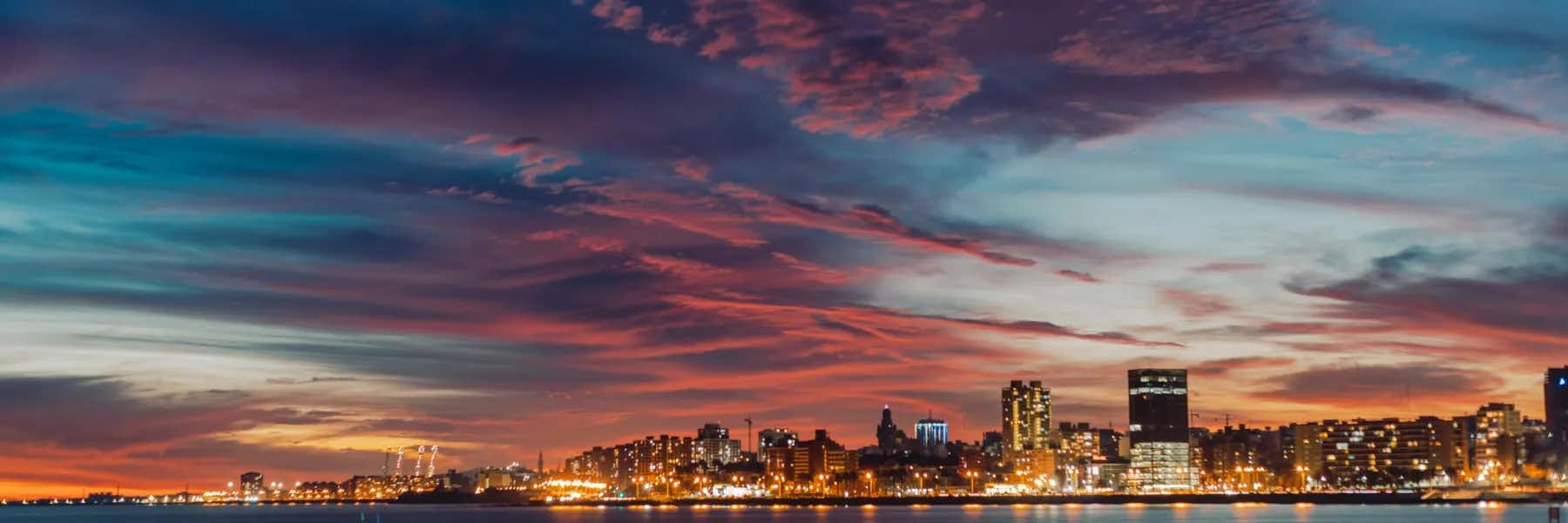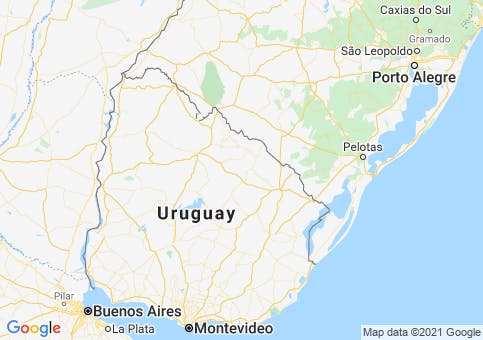Are you looking for an international real estate opportunity in a country where it’s safe to invest; where you, as a non-citizen, can hold full title to a property; and where you can choose from a variety of interesting property types and price ranges?
If your answer is yes, you need to know about real estate in Uruguay.
Uruguay is a Safe Place to Invest
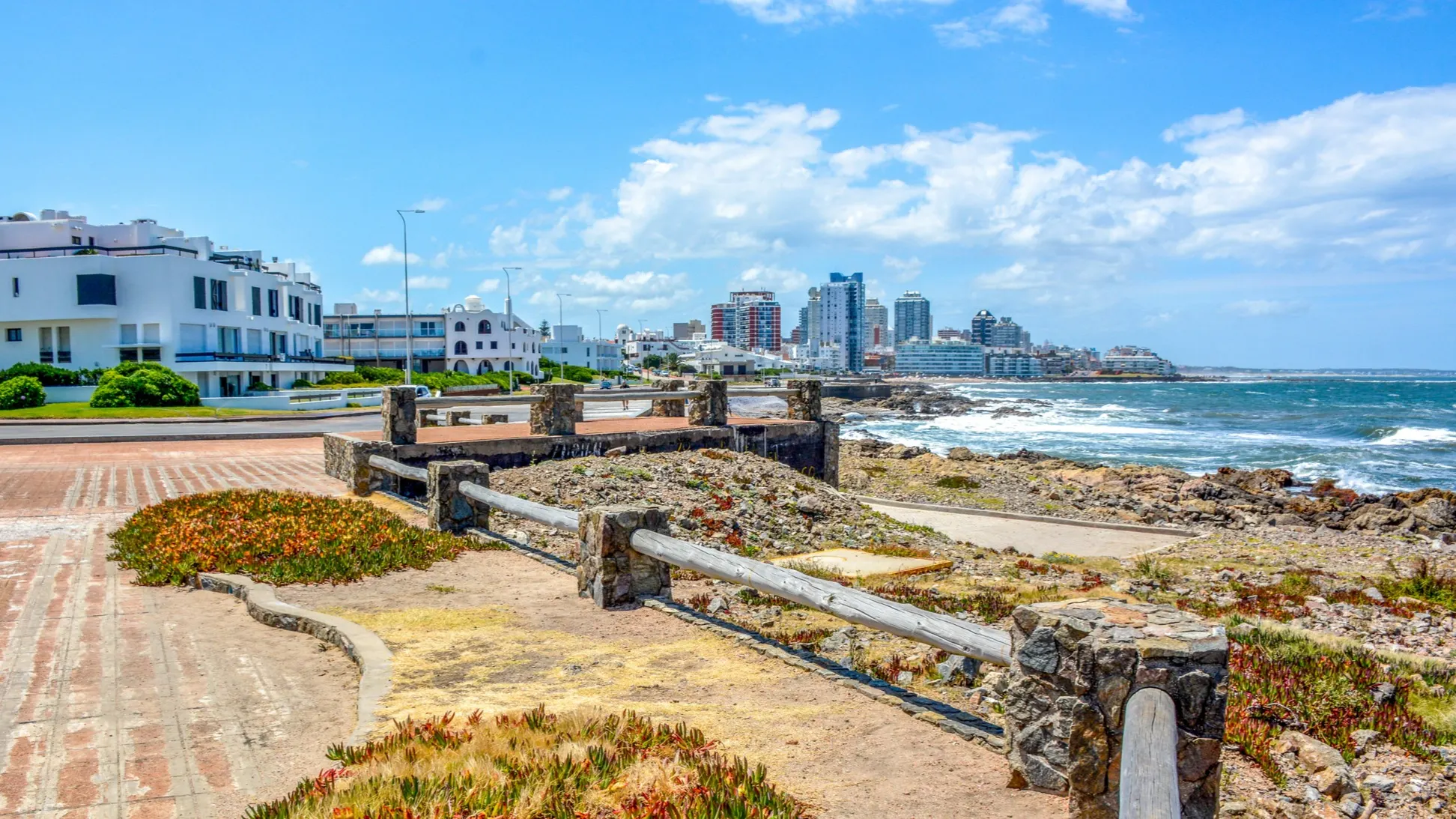
Uruguay is known for its stability. It's one of the main reasons many Brazilians, Argentines, and investors from around the world buy real estate in Uruguay.
Most real estate in Uruguay is bought and sold in U.S. dollars. This eliminates the cost of converting purchase and sale proceeds from one currency to another. It also removes the risk of changes between currency values during a transaction.
In Uruguay, non-citizens can own full title to real estate without jumping through hoops
In Uruguay, you, as a foreign individual, can buy and hold real estate in your own name. You don’t need a local partner, a trust, or a corporation. You don’t even need to become a legal resident or get a Uruguayan tax identification number. And you can own any type of real estate, the same as a Uruguayan citizen. That includes property near a coast and agricultural land.
Uruguay Offers a Variety of Interesting Properties
Real estate opportunities in Uruguay include:
City apartments
Beach resort apartments
Single-family homes in a beach resort
Single-family homes in small coastal towns
Beach lots
Executive homes in private communities
Country estates (called chacras)
And farmland.
The most popular real estate investment among foreign buyers is apartments in the capital, Montevideo. The second most popular is apartments and single-family homes in the beach resort town of Punta del Este.
The World’s Best Retirement Havens for 2025
The World’s Best Retirement Havens for 2025
To get further information on Uruguay and more retirement destinations, sign up to receive your free report: 20 Countries Compared, Contrasted, Ranked, and Rated.
You don’t have to be rich to enjoy a pampered retirement, you just need to know where to go.
With our 34th Annual Global Retirement Index, our experts hand you a detailed roadmap. Details and a Special Offer Here!

By submitting your email address, you will receive a free subscription to IL Postcards and special offers from International Living and our affiliates. You can unsubscribe at any time, and we encourage you to read more about our Privacy Policy.
Montevideo
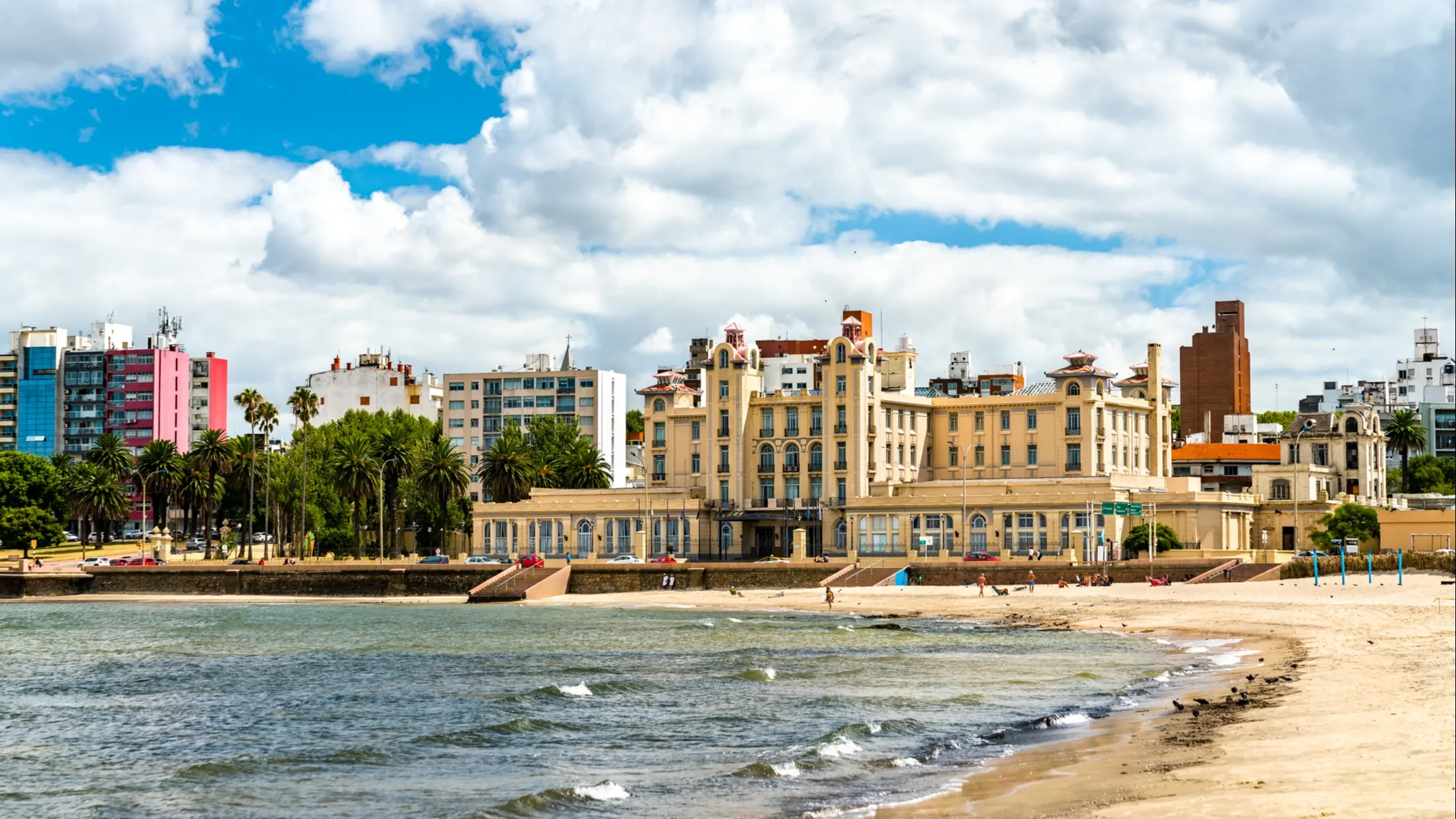
Montevideo is Uruguay’s commercial and cultural center with a population of 1.4 million. It’s a city with picturesque plazas, sycamore-lined streets, and sand beaches. A wide walkway called the rambla runs the full length of the city’s coastline. In Montevideo, you’ll find plenty in the way of dining and entertainment. Cultural events include Carnival parades, rodeos, and opera.
The most popular part of Montevideo for part-time and full-time living is the Pocitos Area. It’s where you find a long sand beach, an 18-hole golf course, two shopping malls, large parks, and a lighthouse.
To give you an idea of what your money can buy in Pocitos, here’s an example:
A one-bedroom 430-square-foot apartment is for sale. It's on the eighth floor of a newer building just three-and-a-half blocks from Pocitos Beach. Features include tile and laminate floors, a kitchenette with a granite countertop, and a balcony off the bedroom. Building amenities include a laundry room and barbecue area. Services include a part-time porter. Price: $147,000 (includes a parking place). Monthly HOA fees: $82.
An area of Montevideo popular with many cost-conscious investors is Ciudad Vieja (Old City). It’s an eight by 12 block neighborhood where Montevideo was founded in 1730. It’s a community filled with interesting period architecture, plazas, and museums.
Prices for apartments in Ciudad Vieja tend to cost less than in the Pocitos Area. Here’s a sample of the types of properties you can find:
A 516-square-foot apartment close to Ciudad Vieja’s Plaza Zabala. It’s in a historic building restored in 2009. On the main level, you find wood flooring, a wood stove, and a balcony. Upstairs is a sleeping loft and the bathroom. Price: $100,000. Monthly HOA fees: $60.
The World’s Best Retirement Havens for 2025
The World’s Best Retirement Havens for 2025
To get further information on Uruguay and more retirement destinations, sign up to receive your free report: 20 Countries Compared, Contrasted, Ranked, and Rated.
You don’t have to be rich to enjoy a pampered retirement, you just need to know where to go.
With our 34th Annual Global Retirement Index, our experts hand you a detailed roadmap. Details and a Special Offer Here!

By submitting your email address, you will receive a free subscription to IL Postcards and special offers from International Living and our affiliates. You can unsubscribe at any time, and we encourage you to read more about our Privacy Policy.
Punta del Este
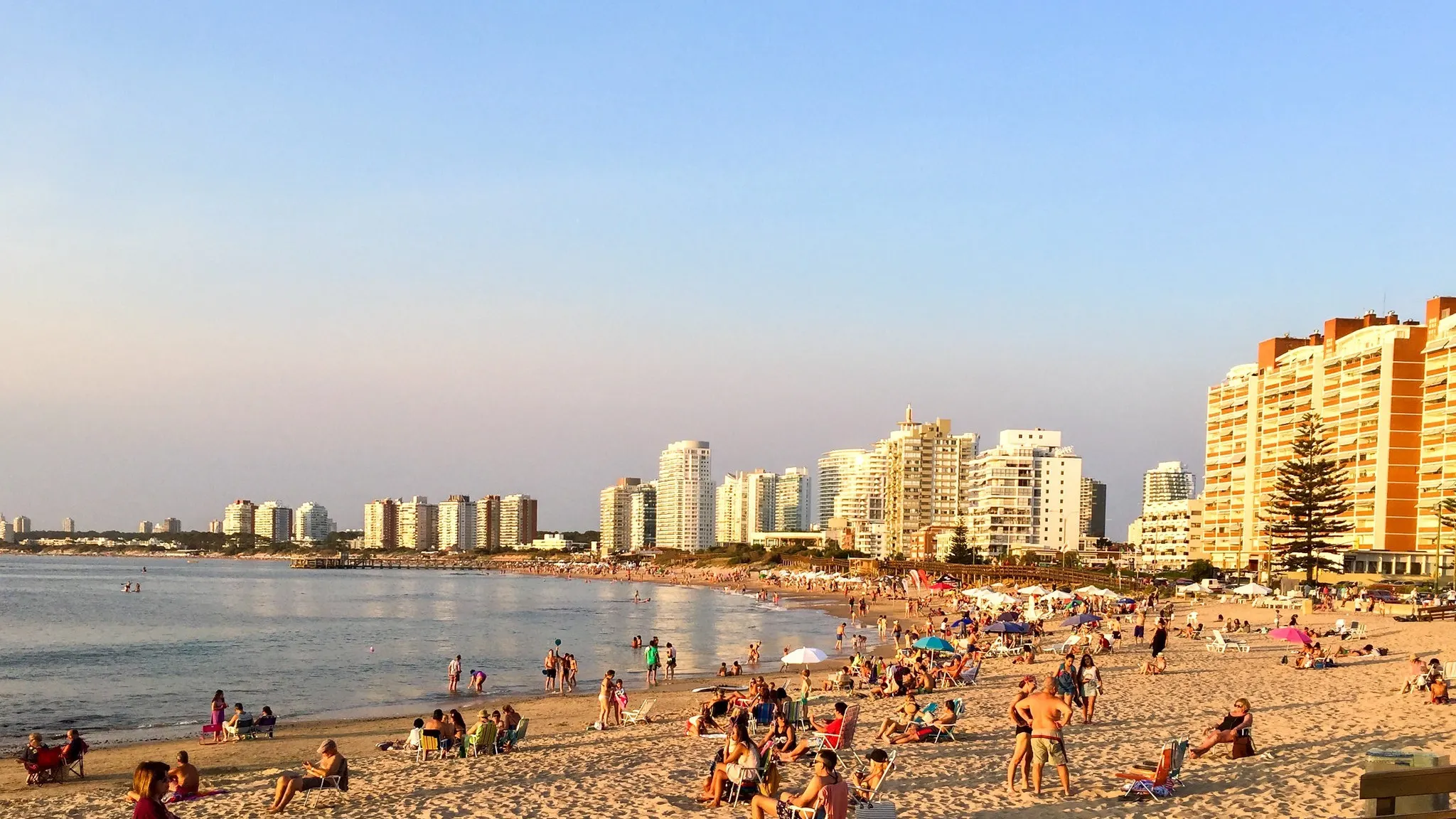
An Apartment in Punta del Este for Vacations and a Seasonal Getaway
Punta del Este is a summer beach resort. While it’s most popular with Argentine and Brazilian vacationers, it also attracts well-connected North Americans and Europeans.
In the 1950s and 60s, visitors to Punta del Este included Frank Sinatra’s Rat Pack and Brigitte Bardot. These days, summer guests include Ralph Lauren, Tommy Hilfiger, and Shakira.
But what may be most unique about Punta del Este is this. While it attracts jet setters it’s not exclusive. What do I mean by that? Here’s an example. It’s customary to go to the end of the Peninsula, by the marina, on Sunday evenings to watch the sunset.
Some watch from the flybridge of a yacht or a patio table of a high-end restaurant. But just yards away, others, with smaller budgets, watch the sunset, too. They watch from blankets on the grass, from folding chairs in the sand, or from where they sit along the seawall. All enjoy the same sunset. All sense they are somewhere special.
The real estate market seems to reflect the social scene. You have plenty in the way of multi-million dollar apartments. But you also find more affordable properties in the same desirable neighborhoods. Places a little smaller, a little older, or a little further from the beach.
The World’s Best Retirement Havens for 2025
The World’s Best Retirement Havens for 2025
To get further information on Uruguay and more retirement destinations, sign up to receive your free report: 20 Countries Compared, Contrasted, Ranked, and Rated.
You don’t have to be rich to enjoy a pampered retirement, you just need to know where to go.
With our 34th Annual Global Retirement Index, our experts hand you a detailed roadmap. Details and a Special Offer Here!

By submitting your email address, you will receive a free subscription to IL Postcards and special offers from International Living and our affiliates. You can unsubscribe at any time, and we encourage you to read more about our Privacy Policy.
What can a value-conscious real estate buyer find in Punta del Este? Here’s an example:
It's a two-bedroom two-bathroom apartment just a few blocks from Punta del Este's popular Brava Beach. This 850-square-foot place is on the 10th floor of a residential tower constructed in 2014. Inside it's light and bright with a black granite countertop in the kitchen, tile flooring, and a balcony. It also comes with a parking place. Building amenities include a heated outdoor pool, gym, sauna, and barbecue area. Building services include 24-hour porter and maid service. (Maid service is daily in the high season and weekly in the low season). Price: $208,000. Monthly HOA fees: $500.
A Single-Family Home near Punta del Este for Year-Round Living
What if you love the beauty of Punta del Este but prefer a single-family home with a yard? If that's the case, consider Pinares. It's a neighborhood six-and-a-half miles west of the Peninsula. Pinares looks and feels like it’s part of Punta del Este. But it’s actually within the city limits of the adjoining middle-class town of Maldonado. So, it’s more affordable.
Here’s a property sample in Pinares:
It’s a 2,000-square-foot two-story home on a 7,300-square-foot lot. Inside you find three-bedrooms two-bathrooms. The living room boasts a floor-to-ceiling slate-clad fireplace. The master bedroom is a suite that includes a jetted tub and a balcony. In the back yard, you find a swimming pool and barbecue area. Price: $220,000.
The World’s Best Retirement Havens for 2025
The World’s Best Retirement Havens for 2025
To get further information on Uruguay and more retirement destinations, sign up to receive your free report: 20 Countries Compared, Contrasted, Ranked, and Rated.
You don’t have to be rich to enjoy a pampered retirement, you just need to know where to go.
With our 34th Annual Global Retirement Index, our experts hand you a detailed roadmap. Details and a Special Offer Here!

By submitting your email address, you will receive a free subscription to IL Postcards and special offers from International Living and our affiliates. You can unsubscribe at any time, and we encourage you to read more about our Privacy Policy.
Buying an Apartment in Uruguay: Insider Tips
By David Hammond

Would you like to own a quality apartment in a stable country with a high quality of life outside the U.S.?
If so, consider Uruguay.
In Uruguay, you find apartments ranging from modest studios to luxury water-view penthouses.
You find the largest concentration of apartments in Uruguay’s capital, Montevideo. It’s a city known for its riverfront promenade, huge green parks, and sycamore lined streets.
After Montevideo, you find the most apartments in Punta del Este. It’s the most prestigious beach city in South America.
In Uruguay, most apartments are bought and sold in U.S. dollars. And you, as a non-resident, can own property in your own name with the same rights as a Uruguayan citizen.
The following are tips for buying an apartment in Uruguay. They are based on my first-hand experience buying apartments in Montevideo and Punta del Este, and include
Where to find apartments for sale
How to choose your apartment-buying team
And recommended due diligence.
The World’s Best Retirement Havens for 2025
The World’s Best Retirement Havens for 2025
To get further information on Uruguay and more retirement destinations, sign up to receive your free report: 20 Countries Compared, Contrasted, Ranked, and Rated.
You don’t have to be rich to enjoy a pampered retirement, you just need to know where to go.
With our 34th Annual Global Retirement Index, our experts hand you a detailed roadmap. Details and a Special Offer Here!

By submitting your email address, you will receive a free subscription to IL Postcards and special offers from International Living and our affiliates. You can unsubscribe at any time, and we encourage you to read more about our Privacy Policy.
Where to Find Apartments for Sale
Real Estate Websites
While you don’t find a multiple listing service in Uruguay, you do find real estate websites that aggregate the listings of many brokers. Here are a few such websites with apartments for sale:
All over Uruguay: https://www.infocasas.com.uy/
In Punta del Este: https://www.apuntavamos.com/
In Montevideo: https://www.apartamentos.com.uy/
Note: Listings on these websites are not always up to date. This is because more than one office may list the same apartment. And when one office gets an accepted offer, they may not notify the other offices.
Newspaper Classified Ads
The most popular newspaper for real estate classified ads in Uruguay is El Pais, which also posts their ads online at https://www.gallito.com.uy/inmuebles/apartamentos.
Real Estate Offices
For listings that may not be posted online, check with real estate offices in neighborhoods of interest.
The World’s Best Retirement Havens for 2025
The World’s Best Retirement Havens for 2025
To get further information on Uruguay and more retirement destinations, sign up to receive your free report: 20 Countries Compared, Contrasted, Ranked, and Rated.
You don’t have to be rich to enjoy a pampered retirement, you just need to know where to go.
With our 34th Annual Global Retirement Index, our experts hand you a detailed roadmap. Details and a Special Offer Here!

By submitting your email address, you will receive a free subscription to IL Postcards and special offers from International Living and our affiliates. You can unsubscribe at any time, and we encourage you to read more about our Privacy Policy.
For Sale Signs
For some apartments on the market, the only advertising is a “For Sale” sign (En Venta) in the window. So, keep an eye out for signs in areas you like.
Building Porters
Who’s among the first in a building to know if an apartment is coming on the market? Often, it’s a building’s porters. So, if you've narrowed your apartment search to a few buildings, talk to the porters who work in them.
Choosing Your Apartment-Buying Team
An apartment-buying team in Uruguay often includes:
A real estate agent
An architect (to inspect the paperwork)
An escribano (often referred to as a notary, is a limited-practice attorney that handles the paperwork)
Real Estate Agent
In Uruguay, the buyer and seller each pay their own ‘side’ of the real estate commission. I've observed seller-side commissions of 3% and buyer-side commissions of 3%, for a total of 6%. Also, the real estate agent’s commission is subject to a 22% value-added tax.
If you buy through the listing broker, they’ll usually collect both sides of the commission.
I recommend choosing your real estate agent before you start looking at properties. That way you don't end up working with someone by chance when you call about a property for sale.
A good real estate agent knows the market, is well-connected, and looks out for your interests. To find a good agent, seek recommendations from other English-speaking expats who’ve purchased property.
When I find a good real estate agent who understands buyer’s agency and fiduciary duty, I explain I’m a ready and willing buyer and want to choose from a wide unbiased selection of properties that fit my criteria. If applicable, I want to see listings from other offices, apartments for-sale-by-owner, and new projects. In exchange, I assure the agent I will pay them a 3% buyers-side commission wherever they find a property I want to buy.
The World’s Best Retirement Havens for 2025
The World’s Best Retirement Havens for 2025
To get further information on Uruguay and more retirement destinations, sign up to receive your free report: 20 Countries Compared, Contrasted, Ranked, and Rated.
You don’t have to be rich to enjoy a pampered retirement, you just need to know where to go.
With our 34th Annual Global Retirement Index, our experts hand you a detailed roadmap. Details and a Special Offer Here!

By submitting your email address, you will receive a free subscription to IL Postcards and special offers from International Living and our affiliates. You can unsubscribe at any time, and we encourage you to read more about our Privacy Policy.
Architect
In Uruguay, the professional who assesses a property's condition is usually an architect. I choose and pay for my own architect, who is not also a friend of the seller or seller’s agent.
Escribano
The escribano (or notary) is the professional you, as a buyer, hire to handle the paperwork. This includes checking the property's title, drafting the sales documents, and recording the deed.
Escribanos charge a percentage of the purchase price for their services. The most common rate I've observed is 3%, plus a 22% value-added tax.
You, as the buyer, pay the escribano. So, just like the rest of your professional team, choose an escribano based on recommendations from other expats who used the escribano’s services when they bought a property.
Note: If you're not fluent in Spanish, use the services of a real estate agent, architect, and escribano that speak English.
The World’s Best Retirement Havens for 2025
The World’s Best Retirement Havens for 2025
To get further information on Uruguay and more retirement destinations, sign up to receive your free report: 20 Countries Compared, Contrasted, Ranked, and Rated.
You don’t have to be rich to enjoy a pampered retirement, you just need to know where to go.
With our 34th Annual Global Retirement Index, our experts hand you a detailed roadmap. Details and a Special Offer Here!

By submitting your email address, you will receive a free subscription to IL Postcards and special offers from International Living and our affiliates. You can unsubscribe at any time, and we encourage you to read more about our Privacy Policy.
Due diligence
Following is the checklist I use once I've identified an apartment of interest.
Visit the apartment of interest at different times
That way, if it turns out the apartment next door is a business with lots of people coming and going during business hours, you’ll know. (Some buildings allow offices as well as residences.) And if there’s an all-night dance bar across the street, you’ll know that, too.
Talk to apartment owners in the building
Introduce yourself to a few of the building’s apartment owners/occupants. Learn how they like owning in the building. Ask about their experience with the property’s administrator. (The administrator is the entity that manages the building’s maintenance and services, and pays the common expenses.)
Talk to the property administrator
After you learn about the experience of a few apartment owners, speak with the property’s administrator to:
Confirm the amount of the apartment’sgastos comunes(common expenses, like HOA fees). Be clear what services are included for the fee. (Common expenses can vary a lot. In some buildings, they might include 24-hour porter service, winter heating for your apartment, and community swimming pool maintenance. In Punta del Este, common expenses can include daily maid service. In general, the fewer the services, and the more apartments sharing the costs, the lower the common expenses.)
Ask about the homeowner association’s solvency. Are the building's maintenance needs adequately funded by the owners?
Ask about any lawsuits or pending lawsuits against the homeowners association? Such legal action would likely be discovered by the escribano. However, finding out sooner may save you time and trouble.
Learn if the administrator foresees any special assessments? Special assessments are levied to each apartment in a building to cover large unbudgeted building costs.
The World’s Best Retirement Havens for 2025
The World’s Best Retirement Havens for 2025
To get further information on Uruguay and more retirement destinations, sign up to receive your free report: 20 Countries Compared, Contrasted, Ranked, and Rated.
You don’t have to be rich to enjoy a pampered retirement, you just need to know where to go.
With our 34th Annual Global Retirement Index, our experts hand you a detailed roadmap. Details and a Special Offer Here!

By submitting your email address, you will receive a free subscription to IL Postcards and special offers from International Living and our affiliates. You can unsubscribe at any time, and we encourage you to read more about our Privacy Policy.
Be clear on all your potential ownership costs
Gastos Comunes
As mentioned, gastos comunes are the common expenses shared by apartment owners or apartment tenants. They pay for lighting the common areas, building staff, landscaping, and normal maintenance.
Heating
Winter heating is a significant cost that can vary quite a bit, depending on the apartment and its heating equipment. So, it's wise to check the apartment's history of winter heating costs. If a history of heating costs isn't available (as is the case of a new apartment), try to find comparable places to get an idea.
Property Taxes
The main property tax in Uruguay is the Contribución Inmobiliaria(real estate contribution), which is a local municipal tax. You also have the Impuesto a la Enseñanza Primaria(primary education tax).
These taxes are based on registered values determined by the government. Registered values are different than a property's market value. To determine the registered values and tax rates for the apartment you're considering, visit the local government office of Dirección Nacional de Catastro.
Another potential tax is an asset tax called Impuesto al Patrimonio. It’s a low-rate graduated tax. Most properties fall below the minimum threshold. But, if you're buying a high-end property, it’s worth getting all the details.
Note: In Montevideo, there is also a residential tax and sanitation fee.
Hire an Architect to Evaluate an Apartment of Interest as well as the Building.
As mentioned, I recommend hiring an architect to inspect the apartment and the building. Even if you don’t have a specific concern, get it checked to avoid unpleasant surprises.
To expedite the process and save on costs, I usually accept a verbal report. I follow the architect around as they inspect, asking questions, and taking notes.
Ask Your Escribano to Briefly Review the Seller's Property Records Before Signing an Agreement and Putting up a Deposit.
One difference between the real estate industries in the U.S. and Uruguay is the listing process.
In Uruguay, there is usually no written listing agreement and no preliminary title search when a property is listed. The only thing known about a property placed on the market is what the person who spoke to the real estate agent represented. (Who many not even be the legal owner.)
The World’s Best Retirement Havens for 2025
The World’s Best Retirement Havens for 2025
To get further information on Uruguay and more retirement destinations, sign up to receive your free report: 20 Countries Compared, Contrasted, Ranked, and Rated.
You don’t have to be rich to enjoy a pampered retirement, you just need to know where to go.
With our 34th Annual Global Retirement Index, our experts hand you a detailed roadmap. Details and a Special Offer Here!

By submitting your email address, you will receive a free subscription to IL Postcards and special offers from International Living and our affiliates. You can unsubscribe at any time, and we encourage you to read more about our Privacy Policy.
The whole truth about a property comes out, after the buyer’s escribano fully researches it. This is a 30-plus day process that normally starts after the buyer signs a Boleto de Reserva(reservation ticket) and puts up a 10 % deposit.
If the escribano finds a problem with the title during this 30-day research period, you, the buyer, are fully excused from the transaction. And you get your full deposit back. However, it’s still a big inconvenience.
After a few times of making a deposit and waiting 30 days, only to find out there were big obvious title problems that prevented a sale, I take a different approach.
I ask my escribano to give the seller’s property documents a quick review before I sign anything or put up a deposit. (Like a preliminary title review.) That way, if there is a glaring issue, I don’t wait a month to find out.
If it looks okay after the escribano’s once over, I sign paperwork, put up the deposit, and move ahead.
After a months’ time, the escribano has checked every corner to make sure nothing in the title or property’s paperwork is amiss. All the i’s are dotted and all the t’s are crossed. And I can move to closing with confidence my new property’s title is secure.
